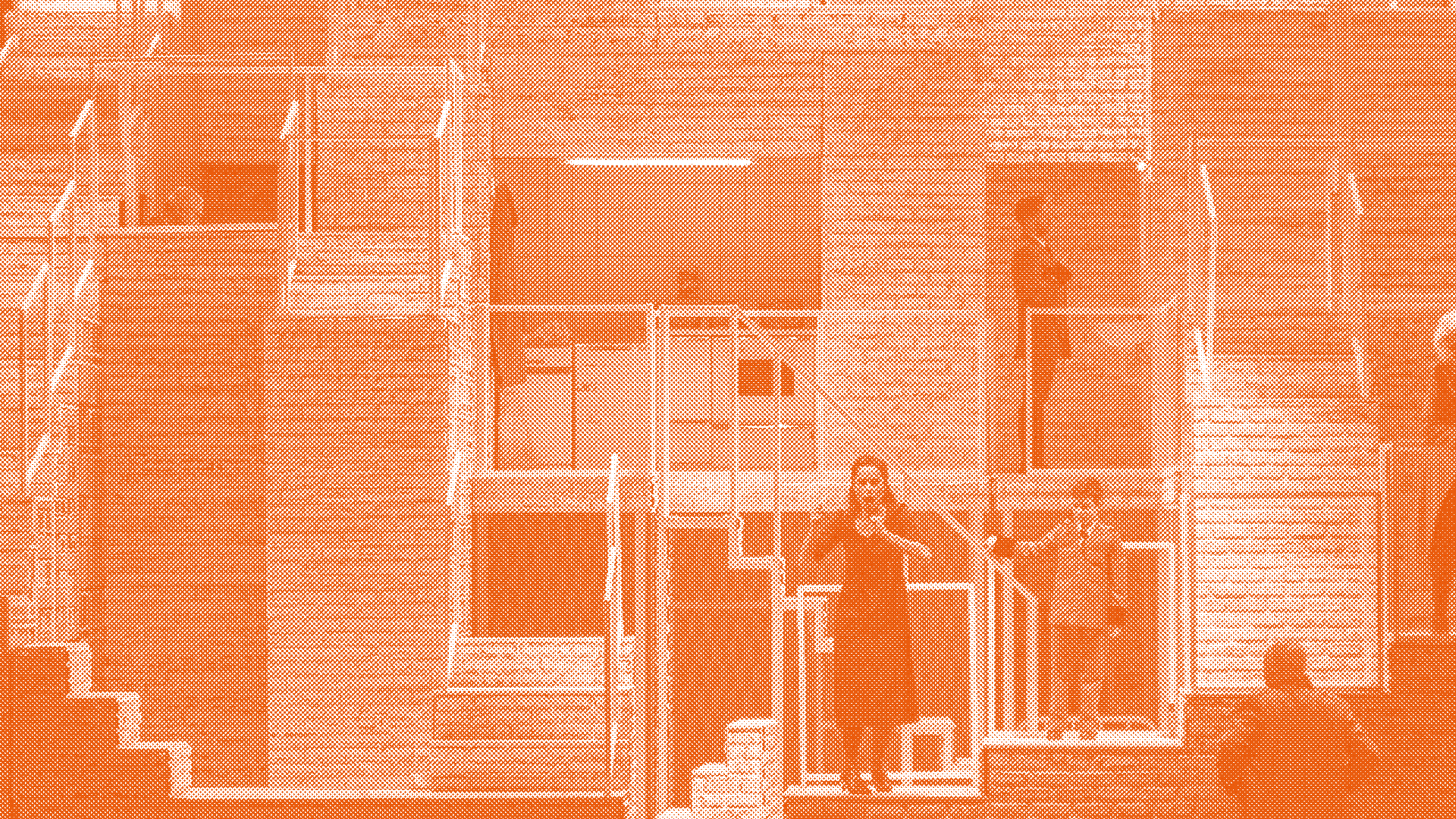
Sustainability
in opera
CHAPTER 1 / INTRODUCTION
How can climate change and environmental sustainability be linked to opera as a genre? Surely they can become sources of inspiration for the creation of opera works, but can they also be linked to other opera-related fields? You can find that out by reading the chapter Sustainability in opera. In this video, Giorgos Koumendakis, the artistic director of the Greek National Opera, talks about the company’s commitment to environmental sustainability.
Giorgos Koumendakis, the artistic director of the Greek National Opera, discusses the company’s approach to the promotion of environmental sustainability and how the GNO managed to minimize the environmental impact of the production Offenbach’s La belle Hélène.
The following texts are written by Artemis Ignatidou.
CHAPTER 2 / WHAT DO WE MEAN BY ‘SUSTAINABILITY’ IN OPERA?
Sustainability is probably the most important source of inspiration for us today. I think that it is a duty, but also a great opportunity. It’s going to be the language of our time. The fragility of our earth provides us with an excellent excuse to change, to be better, because it’s a pure force of necessity.
— Renzo Piano, SNFCC Architect
Climate change and visions of ‘sustainability’ that will keep our planet habitable for all species have been at the centre of discussion for the past few decades. Lately, extreme weather conditions linked to climate change have mobilised citizens and organisations. The theory of ‘sustainability’, which proposes a measured and renewable use of earth’s natural resources in order to avoid their depletion, is already being applied in a wide array sectors including transportation, waste management, and fashion. Just like you and I stopped using plastic straws in the hopes of saving the life of a sea- turtle or two, important operatic companies around the world implemented ‘green’ policies in order to reduce their use of natural resources in opera production. Because what we see on stage may simply look like singing and dancing but its production is supported by a complex technological and administrational infrastructure that consumes increasing amounts of energy with time.
Some of the fundamental issues relating to the environmental footprint of opera production include: energy consumption management in opera houses, the digitalisation of administration, the logistics of opera production, storage and transportation of scenery and costumes, as well as the ecological consequences of the transportation of opera workers and audiences.48M. Roca – J. Alberti – A. Bala – L. Batlle-Bayer – J. Ribas-Tur – P. Fullana-y-Palmer, “Sustainability in the Opera Sector: Main Drivers and Limitations to Improve the Environmental Performance of Scenography”, Sustainability, 13 (22), 2021, 12896, σ. 2, 4.

In this section we will see examples of how different opera companies around the world responded to society’s call for action against climate change.
In the past ten years, the leading opera houses of Milan (Italy), Sydney (Australia), Lyon (France), Gothenburg (Sweden) and Tunis (Republic of Tunisia) have forged collaboration in order to exchange know-how on energy-saving measures. More specifically, the Sydney Opera House has implemented an extensive range of energy-saving measures that include the recycling of commercial and building materials, and the use of renewable energy sources, and has achieved a net zero carbon footprint for its building since 2018.49https://www.sydneyoperahouse.com/about-us/in-the-community/environmental-sustainability Similarly, since 2022 the new administration buildings of the Teatro alla Scala in Milan have relied on solar panels for their energy needs, the digitalisation of administrational bureaucracy has saved ten tonnes of paper per year, and the use of energy-saving lamps has reduced the carbon footprint of the opera house by 630 tonnes in the past ten years.50R. Schmid, «How operas are going green», The New York Times, 10.5.2021, https://www.nytimes.com/2021/05/10/arts/music/opera-sustainability.html (τελευταία πρόσβαση: 14.2.2022).
In the United Kingdom, ‘Opera North’ in the city of Leeds and ‘Glyndebourne Opera’ in Sussex have been commended for their ecological efforts. Glyndebourne Opera became energy- efficient by installing a wind turbine, and reduced its energy consumption by modernising its ventilation and heating systems, and by installing energy-saving lamps in its buildings. These measures led to the reduction of the opera house’s energy consumption by 83% between 2009 and 2020.51S. Chebil, «UK-based opera house Glydebourne targets net zero, prioratizes climate action throughout business», 12.8.2021, https://smeclimatehub.org/uk-based-opera-house-glyndebourne-targets-net-zero-prioritizes-climate-action-throughout-business/ (τελευταία πρόσβαση: 14.2.2022). Since 2021, Glyndebourne Opera has relied entirely on ‘green’ energy for its needs, while it also participates in the global environmental campaign ‘Race to Zero’- aiming to achieve net zero carbon footprint by 2050.52F. Lockheart, «Glyndebourn opera house celebrates wind turbine anniversary with push for carbon neutrality», 26.1.2022, https://www.classical-music.uk/news/article/glyndebourne-opera-house-celebrates-wind-turbine-anniversary-with-push-for-carbon-neutrality (τελευταία πρόσβαση: 14.2.2022). Opera North, on the other hand, has created a special taskforce to regulate the energy consumption of the organisation, it implements programmes for the reduction of waste as well as staff trainings on environmental issues, and it also announced future funding for the production of an opera on climate change.53Leeds Climate Commission, «Opera North Cutting Carbon», https://www.leedsclimate.org.uk/opera-north-cutting-carbon (τελευταία πρόσβαση: 14.2.2022).
With climate change receiving increasing public attention recently, artists are responding to calls by organisations for the production of works examining the relationship of the human race to our natural environment. See for example the opera Anthropocene (2019) by ‘Opera Scotland’ and CO2 (2015) staged in La Scalla in Milan.54https://operavision.eu/en/library/performances/flashback/anthropocene-scottish-opera
Does the example of artists responding to issues relevant to their own time help you understand historical works better? How did artists of the past address problems of their societies in their works?
CHAPTER 3 / A ‘GREEN’ OPERA HOUSE LOOKING TOWARDS A SUSTAINABLE FUTURE

Snapshot from Dimitris Kamarotos and Anna Pangalos’s ‘Suspended’, performed at the Energy Canopy of the Stavros Niarchos Foundation Cultural Centre, photo by Yiorgis Yerolymbos.
In 2017 the Greek National Opera moved to its new building at the Stavros Niarchos Foundation Cultural Centre (SNFCC), a building complex with a public space adhering to the highest environmental standards in urban planning.
The park that surrounds the SNFCC offers innovative solutions to the energy needs of the organisations it hosts. Next time you attend the opera keep in mind that the park has been designed to promote the principles of water conservation, recycling, and sustainable transportation. Moreover, there is even an unfathomable technology above your head. That is the Energy Canopy that is suspended 17 metres above the GNO building and measures 10,000 m2, it is covered with 5,700 solar panels, and it has the capacity of covering 23% of the SNFCC’s energy needs.55https://www.snfcc.org/kpisn/sustainability (τελευταία πρόσβαση: 14.2.2022). In 2020, at the Energy Canopy, composer Dimitris Kamarotos and mezzo-soprano Anna Pangalou presented ‘Suspended’– inspired by Kiki Dimoula’s poem ‘A Lady Suspended’– a music performance that explores the relationship between humans, culture, nature, and art in urban settings.56https://www.snf.org/el/grafeio-typou/lista-neon/2020/05/apo-tin-koryfi-tou-kpisn-live-o-dimitris-kamarotos/
Moreover, while the Canopy on top of it transforms the Mediterranean sunlight into electricity, the rest of the building is also designed to take advantage of natural light and to reduce energy consumption through a smart central management system that keeps the LED lights on only when it detects movement.
And if before of after the opera you decide to take a stroll in the park, there you will find mainly drought tolerant flora– that is, plants that do not need a lot of water to survive. Because water conservation has been central in the SNFCC’s planning, irrigation does not depend on the Marathon Reservoir but on seawater collected nearby, desalinated, and used to cover all of the park’s irrigation needs. This cycle of sustainability is completed through the utilization of the fruit collected from the trees and the other plants of the park for the production of commercial goods, such as olive-oil soap.57https://www.classical-music.uk/news/article/glyndebourne-opera-house-celebrates-wind-turbine-anniversary-with-push-for-carbon-neutrality You can find more information on the SNFCC’s sustainable features in the following link:
https://www.snfcc.org/sites/default/files/sitefiles_2022-05/snfcc_hub_digital.pdf
Another exciting feature of the Greek National Opera’s environmental vision is the inclusion of works about the environment in its artistic programming. In 2019, for example, the Alternative Stage of the GNO presented the music theatre ‘Four Seasons’, based on the Four Seasons [Le Quattro Stagioni] by composer Antonio Vivaldi, a work that aimed to familiarise children with the ideas of circular economy and sustainability.58https://www.nationalopera.gr/enalaktiki-skini/parastaseis-gia-paidia/item/2721-tesseris-epoxes
Excerpt from the ‘Four Seasons’, a GNO Alternative Stage commission. Patari Project theatre group, Alternative Stage, 2019/2020.
Similarly, in 2017, the GNO Learning & Participation Department realised the project ‘The Park of the Operaphore plants’, a series of cross-art workshops that encouraged the creation of artistic works inspired from nature
CHAPTER 4 / WHAT CAN WE DO?
Climate change has consequences for all species inhabiting our planet and yet it has been linked directly to irresponsible human activities.
The world of opera, a global industry with a sizeable audience that is responsible for its environmental footprint, should step up, and take accountability and action towards diminishing the environmental impact of operatic productions. It will not always be easy and of course responsibility is not equally shared between opera houses and the audience. Therefore, on top of giving up our plastic straws– a minor inconvenience by any measure– we can start using public transportation or share a single car with our friends for our trip to the theatre. We can download a digital programme or share a printed one and then recycle it, instead of wasting paper. We can write letters and emails to our organisations of interest and demand that they implement demonstrably environmentally friendly policies.
Our most important task, though, will be to hold organisations accountable for their promises towards protecting the environment, demand that they take meaningful, long-term action to protect it, and not use environmental protection simply as advertising– a practice called ‘greenwashing’. Unfortunately, climate change is a problem that began many decades ago and it is not one of those problems we can easily “solve” and move on with our life. It is one of those problems that require us to change the way we live in order to make sure that the next opera we watch does not take place underwater, in a seabed with absolutely no fish.

Search online about the environmental footprint of video streaming. How much energy is consumed when we stream content and how much when we search online?
QUIZ / SUSTAINABILITY IN OPERA
ACTIVITIES / SUSTAINABILITY IN OPERA
Introduction
One of the main practices of sustainable living is re-using material. In the following activity we will create stage scenery for the opera Rigoletto by Giuseppe Verdi, using exclusively material from our everyday life. What exactly is a court jester and which objects would we like him to use in our opera? How can we give simple material and objects a second, creative life as part of an opera production?
Connection to the curriculum
– Music
– Informational Technology
Subjects
– Scenery and costumes
– Re–using material
– Circular economy
Suggested teaching hours
3 teaching hours
Educational objectives
– Familiarization with environmental issues
– Familiarization with the cross– art aspects of opera
– Cultivating imagination
– Exploring creativity
– Promotion of collaborative practices (in the classroom)
Step 1
Read the synopsis of Giuseppe Verdi’s Rigoletto in class:
The opera Rigoletto revolves around the stories about the relationship between the Duke of Mantua and jester Rigoletto. The Duke of Mantua lives without constraints, indulging in pleasures, in the company of numerous women. Rigoletto, the hunchback jester at his court, is faced with a terrible curse that was cast upon his beloved daughter Gilda. Terrified by the curse and anxious about his daughter’s safety, Rigoletto hides her in a faraway place. Yet there is a detail that he is unaware of: his daughter Gilda has fallen in love with the Duke, who presented himself to her in the guise of a destitute student. A group of noblemen accompanying the Duke, who want to take revenge on Rigoletto because he mocks them about their wives’ affairs with the Duke, abduct Gilda, under the impression that she is Rigoletto’s mistress. When it turns out that Gilda is actually Rigoletto’s daughter, not his mistress, those two return home feeling disgraced. There Gilda tells her father what happened in the manor where they were keeping her locked. Rigoletto is determined to take vengeance on the Duke, however Gilda begs him to change his mind and forgive him. Rigoletto, committed to his decision, hires an assassin to kill the Duke. Gilda, however, finding out how the Duke is going to be murdered, decides, without much thought, to sacrifice herself to save him, although she knows he has been unfaithful to her. The assassin attacks her, believing she is the Duke, and she collapses. Holding the murderer’s fee in his hands, Rigoletto receives a sack allegedly containing the Duke’s corpse, and as he is ready to throw it into the river, he hears the Duke’s voice singing. Taken aback, he opens the sack and discovers his daughter severely injured. A while before she passes away, Gilda confesses to him that she is happy she died instead of the man she loves, and then draws her last breath in her father’s arms. His worst fears about the curse have come true.
Step 2
Watch a performance of the aria ‘Cortigiani, vil razza dannata’ by Dimitris Tiliakos. In the following excerpt Rigoletto begs the courtiers of the Duke of Mantua to return his daughter, Gilda, to him.
Dimitris Tiliakis performing the aria ‘Cortigiani, vil razza dannata’ from Giuseppe Verdi’s Rigoletto in the Odeon of Herodes Atticus.
Step 3
Now that you know more about the plot of the opera can you re-use materials to create objects for it? As we saw, Rigoletto is a court jester; before you create props for him keep in mind the following questions:
– Which objects belonged to a court jester?
– Which objects did he use for his profession?
– Can you imagine a contemporary ‘Rigoletto’? What would he look like if you had the opportunity to bring him to life through creating the objects he used on stage?
After answering these questions and keeping good notes, you can design opera scenery and even a proper model of your stage. Your props and your model should be made out of material we use in our everyday life, before we ‘part’ with them in the (recycling) bin. How can we give this material a second, creative life in the world of opera?




